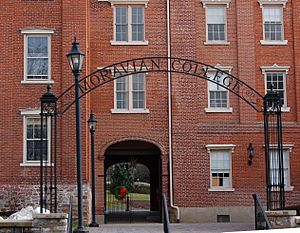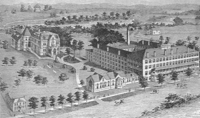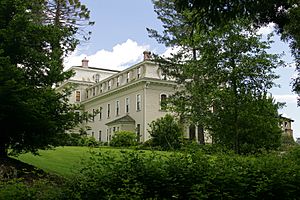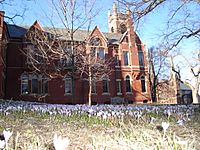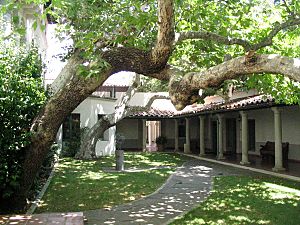Timeline of women's colleges in the United States facts for kids
Women's colleges in the United States are special schools. They are places where mostly women go to learn after high school. These colleges are often focused on a wide range of subjects, like arts and sciences. As of 2021, there are about 35 active women's colleges in the U.S. This article shares when some of these important schools first opened their doors.
Contents
First Women's Colleges in the U.S.
Many early schools for women started differently. They might have been schools for girls, or "academies." Academies were like high schools in the past. Some were also "seminaries" for teaching. In the 1800s, seminaries trained women to become teachers. Teaching was one of the few jobs considered proper for unmarried women. Many of today's women's colleges grew from these early teaching seminaries. They helped create many important educators.
Here are some of the very first and oldest schools for women:
- 1742: Bethlehem Female Seminary (now Moravian College). This school started as a seminary for girls. It later became a college for women. Eventually, it joined with other schools to become a college for both boys and girls.
- 1772: Salem College in North Carolina. This school started as the Little Girls' School. It was founded by a group called the Moravian Single Sisters. It is the oldest school for women that has been open continuously.
- 1803: Bradford Academy (later Bradford College). This was the first academy in Massachusetts to let women attend. Its first graduating class had more women than men.
- 1818: Elizabeth Female Academy. This was the first school for girls in Mississippi. It closed in 1843.
- 1821: Clinton Female Seminary in Georgia. This school later joined with others to become Georgia Female College. Today, it is Wesleyan College. It was the first school planned from the start as a full college for women.
- 1827: The Linden Wood School for Girls (now Lindenwood University). This was the first college for women west of the Mississippi River.
- 1833: Columbia Female Academy (now Stephens College). This school started as an academy for high school and college-aged women. It later became a four-year college. It is the second oldest women's college still open today.
- 1836: Wesleyan College in Macon, Georgia. This is the oldest school that was created from the very beginning as a full college for women. It offered the same education as colleges for men. It also gave the first known bachelor's degree to a woman.
- 1837: St. Mary's Hall (now Doane Academy). This school was started by a church leader. It was the first school in the U.S. founded on church principles for women.
- 1837: Mount Holyoke College (Mount Holyoke Female Seminary). This is the oldest of the famous Seven Sisters colleges. It was also the first school started to be a college-level institution for women that is still a women's college today.
- 1838: Judson College for Women in Alabama. This school was also meant to be a college from the start. When it closed in 2021, it was the fifth oldest women's college.
- 1842: Valley Union Seminary (now Hollins University). This is the oldest women's college in Virginia to be officially recognized as a college.
- 1844: Saint Mary's College (Indiana). This was the first women's college in the Great Lakes region.
- 1845: Baylor Female College in Texas. It was officially recognized by the Republic of Texas.
- 1845: Limestone College in South Carolina. This was the first women's college in South Carolina. It became a school for both boys and girls in the 1960s.
- 1848: Moore College of Art and Design (Philadelphia School of Design for Women). This is the first and only art school that is a women's college.
- 1850: Women's Medical College of Pennsylvania (now part of Drexel University). This school trained the first female doctors in the country. It also trained the first Black female doctors.
- 1851: Cherokee Female Seminary. This was the first college just for women west of the Mississippi River. It was also the first college created by a Native American tribe, not the U.S. government.
- 1851: Auburndale Female Seminary (now Lasell College). This was the first "junior college" for women that lasted a long time. Junior colleges offer two-year degrees. It later started offering four-year degrees and became a school for both boys and girls in 1997.
- 1851: Tennessee and Alabama Female Institute (later Mary Sharp College). This was the first women's college to give degrees that were equal to those given to men. It closed in 1896.
- 1851: College of Notre Dame (now Notre Dame de Namur University). This was the first women's college in California. It was also the first in the state allowed to give bachelor's degrees to women. It is now a school for both boys and girls.
- 1852: Young Ladies Seminary (now Mills College). This was the first women's college west of the Rocky Mountains.
- 1853: Mt. Carroll Seminary (now Shimer College). This women's seminary became a school for both boys and girls in 1950.
- 1854: Columbia College in South Carolina. This college survived a war and several fires. A famous artist, Georgia O'Keeffe, taught here for a year.
- 1855: Elmira Female College (now Elmira College). This is the oldest college still open that gave women degrees equal to men's. It became a school for both boys and girls in 1969.
- 1861: Vassar College. This is one of the Seven Sisters colleges. It started as a college just for women. It became a school for both boys and girls in 1969.
- 1867: Cedar Crest College. This college started in a church basement. Today, it is a leading women's college.
- 1867: Scotia Seminary (now Barber-Scotia College). This was the first historically Black college for women after the American Civil War. It became a women's college in 1946. It later became a school for both boys and girls.
- 1868: Wells College in New York. It became a school for both boys and girls in 2005.
- 1869: Wilson College in Pennsylvania. It became a school for both boys and girls in 2014.
- 1869: Chatham University in Pittsburgh, Pennsylvania. It started as Pennsylvania Female College. It became a university in 2007.
- 1870: Wellesley College was officially recognized. It opened in 1875. It is one of the Seven Sisters colleges that started as a women's college and still is one today.
- 1871: Smith College was officially recognized. It opened in 1875. It is another one of the Seven Sisters colleges that started as a women's college and still is one today.
- 1871: Ursuline College in Ohio. It was founded by a group of Catholic Sisters. It is still a college mainly for women today. It is known for its nursing programs.
- 1878: Georgia Baptist Female Seminary (now the Brenau University Women's College). This college was never officially linked to a church. It still has a strong Women's College today. Its motto means "as gold made pure by fire."
- 1881: Atlanta Baptist Female Seminary (now Spelman College). This was the first historically Black college for women to be officially recognized as a college. This makes it the oldest historically Black women's college.
- 1884: Industrial Institute & College (now Mississippi University for Women). This was the first public college for women. It became a school for both boys and girls in 1982. However, it kept its original name.
- 1884: Vernon Seminary (now Cottey College). This college was later given to the P.E.O. Sisterhood group.
- 1885: Bryn Mawr College was founded. It is another one of the Seven Sisters colleges that started as a women's college and still is one. It aimed to give women a strong education and a chance to do original research.
- 1893: The Woman's College of Frederick (now Hood College). This college moved to Maryland to serve women in that area.
- 1895: Notre Dame of Maryland University (College of Notre Dame of Maryland). This was the first Catholic women's college in the U.S. to offer a four-year bachelor's degree.
Timeline of Women's Colleges
Early Schools: Before 1830
- 1742: Bethlehem Female Seminary: Started in Pennsylvania. It became Moravian College, a school for both boys and girls, in 1954.
- 1772: Little Girls' School (now Salem College): Located in North Carolina. It is the oldest school for women that is still a women's college. It is also the oldest women's school in the Southern U.S.
- 1787: Young Ladies' Academy of Philadelphia.
- 1792: Mrs. Rowson's Academy for Young Ladies in Boston, MA. This school was started by a writer and actress.
- 1792: Litchfield Female Academy in Connecticut. This school closed in 1833.
- 1803: Bradford Academy (now Bradford College): Started as a school for both boys and girls. It became a college for women in 1836. It went back to being a school for both boys and girls in 1972.
- 1814: Louisburg Female Academy (now Louisburg College): Founded in North Carolina.
- 1814: Nazareth Academy (now Spalding University): Started in Kentucky. It was allowed to give degrees in 1829. It became a school for both boys and girls in 1973.
- 1814: Troy Female Seminary in New York. It became the Emma Willard School in 1895.
- 1818: Elizabeth Female Academy: The first women's school in Mississippi. It closed in 1843.
- 1821: Clinton Female Seminary: In Georgia. This school was a start for Wesleyan College.
- 1827: The Linden Wood School for Girls (now Lindenwood University): In Missouri. It became a school for both boys and girls in 1969.
- 1828: Ipswich Female Seminary in Massachusetts. This was the first women's seminary to have money set aside for it. It also gave diplomas to its graduates. It closed in 1876.
Growth in the 1830s and 1840s
- 1833: Columbia Female Academy (now Stephens College): Started as an academy. It later became a college. It is the second oldest women's school still open as a women's college.
- 1836: Wesleyan College: In Georgia. It is the world's oldest women's college. It is still a women's college today.
- 1837: Mount Holyoke College (Mount Holyoke Female Seminary): This is the oldest of the Seven Sisters colleges.
- 1838: Judson Female Institute: In Alabama. It became Judson College.
- 1841: Saint Mary-of-the-Woods College: Founded in Indiana by a French nun. It is the oldest Catholic liberal arts college for women in the U.S. Its main campus program is still all-female. However, it became fully a school for both boys and girls in 2015.
- 1842: Valley Union Seminary (now Hollins University): Started in Virginia. It became a school just for women in 1852.
- 1842: Augusta Female Seminary (now Mary Baldwin University): In Virginia. Its main college for traditional students started letting men attend in 2017.
- 1844: Saint Mary's College (Indiana): Founded by the Sisters of the Holy Cross. It was the first college in the U.S. to give advanced degrees in theology to women.
- 1848: Moore College of Art and Design (Philadelphia School of Design for Women): This is the first and only art school that is a women's college.

- 1849: The Oread Institute in Massachusetts. It closed in 1881.
Mid-1800s: More Colleges Emerge
- 1850: Women's Medical College of Pennsylvania: Trained the first female doctors in the country.
- 1851: Cherokee Female Seminary: The first college just for women west of the Mississippi River.
- 1852: Young Ladies Seminary (now Mills College): The first women's college west of the Rocky Mountains. It will close in 2023.
- 1853: Mt. Carroll Seminary (now Shimer College): Became a school for both boys and girls in 1950.
- 1854: Columbia College in South Carolina.
- 1855: Elmira Female College (now Elmira College): The oldest college still open that gave women degrees equal to men's. It became a school for both boys and girls in 1969.
- 1857: Peace Institute (now William Peace University): In North Carolina. It became a school for both boys and girls in 2012.
- 1858: Whitworth Female College in Mississippi.
Late 1800s: New Era of Women's Education
- 1861: Vassar College: The first of the Seven Sisters colleges to be founded as a women's college. It became a school for both boys and girls in 1969.
- 1867: Cedar Crest College: Still a women's college today.
- 1867: Scotia Seminary (now Barber-Scotia College): The first historically Black college for women after the Civil War.
- 1868: Wells College: Became a school for both boys and girls in 2005.
- 1869: Chatham University: Started as Pennsylvania Female College. Its undergraduate college for women is still women-only.
- 1869: Wilson College: Became a school for both boys and girls in 2013.
- 1870: Hunter College: Became a school for both boys and girls in the 1950s.
- 1871: Ursuline College: Ohio's first women's college. It is still mainly for women.
- 1873: Bennett College: Started as a school for both boys and girls. It became a women's college in 1926.
- 1875: Wellesley College: One of the Seven Sisters colleges. It remains a women's college.
- 1875: Smith College: Another one of the Seven Sisters colleges. It also remains a women's college.
- 1878: Georgia Baptist Female Seminary (now the Brenau University Women's College): Still has a strong Women's College today.
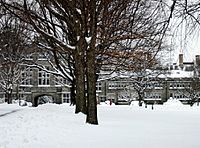
- 1881: Atlanta Baptist Female Seminary (now Spelman College): The oldest historically Black women's college.
- 1884: Industrial Institute & College (now Mississippi University for Women): The first public women's college.
- 1885: Bryn Mawr College: One of the Seven Sisters colleges. It remains a women's college.
- 1886: H. Sophie Newcomb Memorial College: The first women's college inside a U.S. university. It closed in 2006.
- 1887: Alverno College.
- 1889: Decatur Female Seminary (now Agnes Scott College): In Georgia. It became Agnes Scott College in 1906.
- 1889: Barnard College: One of the Seven Sisters colleges.
- 1889: Converse University: Became a university in 2021. Its main undergraduate program became a school for both boys and girls at that time.
- 1891: Pembroke College: This was the women's college for Brown University. It joined with Brown in 1971.
- 1891: Randolph-Macon Woman's College: It became a school for both boys and girls and changed its name to Randolph College in 2007.
- 1891: Baptist Female University (now Meredith College): In North Carolina.
- 1893: The Woman's College of Frederick (now Hood College): Became a school for both boys and girls in 2002.
- 1897: Trinity Washington University (Trinity College).
- 1899: Simmons College (Massachusetts).
20th Century Colleges
- 1901: Sweet Briar College.
- 1901: Girls Industrial College (now Texas Woman's University): It has been a school for both boys and girls since 1994, but most students are still women.
- 1903: Margaret Morrison Carnegie College: This was the women's college for Carnegie Mellon University.
- 1903: Young Woman's Industrial Club (now Skidmore College): Became a school for both boys and girls in 1971.
- 1905: St. Catherine University (known as the College of St. Catherine before 2009).
- 1908: Georgian Court University: Started letting male day students in 2012.
- 1908: William Smith College: Eventually became a college for both boys and girls known as Hobart and William Smith.
- 1908: The State Normal and Industrial School for Women at Harrisonburg: Became a school for both boys and girls in 1966.
- 1908: State Normal and Industrial School for Women at Fredericksburg: Became a school for both boys and girls in 1970.
- 1909: Lesley College: Became a school for both boys and girls in 2005.
- 1911: Pine Manor College: Became a school for both boys and girls in 2014.
- 1911: Connecticut College: Became a school for both boys and girls in 1969.
- 1913: College of Saint Benedict: This college has worked with the all-male Saint John's University since 1955. They share classes, but still have separate living areas and sports.
- 1916: Russell Sage College: Became a school for both boys and girls in 2020.
- 1918: New Jersey College for Women (now Douglass College): This was the women's college for Rutgers University. It is now a special program for undergraduate women at Rutgers.
- 1919: Emmanuel College, Boston: Became a school for both boys and girls in 2001.
- 1921: Rosemont College.
- 1923: College of Saint Mary.
- 1925: Mount St. Mary's College.
- 1926: Sarah Lawrence College: Became a school for both boys and girls in 1968.
- 1926: Scripps College.
- 1927: Regis College: Became a school for both boys and girls in 2007.
- 1928: Elms College: Became a school for both boys and girls in 1998.
- 1932: Bennington College: Became a school for both boys and girls in 1969.
- 1932: Saint Joseph College (Connecticut) (now University of Saint Joseph): It started letting male students into its main program in 2018.
- 1936: Marymount Manhattan College: It is currently a school for both boys and girls.
- 1954: Stern College for Women.
- 1963: Pitzer College: Became a school for both boys and girls in 1970.
- 1982: Colorado Women's College: Reclaimed its old name in 2013 and closed in 2020.
Images for kids


